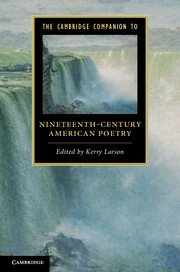Book contents
- Frontmatter
- Introduction
- I MANDATES, MOVEMENTS, AND MANIFESTOES
- II INDIVIDUAL AUTHORS
- 8 Longfellow’s ambivalence
- 9 Sarah Piatt’s grammar of convention and the conditions of authorship
- 10 Poe and Southern poetry
- 11 The color line: James Monroe Whitfield and Albery Allson Whitman
- 12 Colonial violence and poetic transcendence in Whitman’s “Song of Myself”
- 13 Emily Dickinson’s “turbaned seas”
- Selected guide to further reading
- Index
- Cambridge Companions to…
11 - The color line: James Monroe Whitfield and Albery Allson Whitman
from II - INDIVIDUAL AUTHORS
Published online by Cambridge University Press: 28 November 2011
- Frontmatter
- Introduction
- I MANDATES, MOVEMENTS, AND MANIFESTOES
- II INDIVIDUAL AUTHORS
- 8 Longfellow’s ambivalence
- 9 Sarah Piatt’s grammar of convention and the conditions of authorship
- 10 Poe and Southern poetry
- 11 The color line: James Monroe Whitfield and Albery Allson Whitman
- 12 Colonial violence and poetic transcendence in Whitman’s “Song of Myself”
- 13 Emily Dickinson’s “turbaned seas”
- Selected guide to further reading
- Index
- Cambridge Companions to…
Summary
Let no man who loves the Negro race then decry poetry, for it is by this and other proofs of genius that our race will be enabled to take its place among the nations of the earth.
Katherine TillmanIn her 1897 review of “Afro-American Poets and Their Verse,” Katherine Tillman, writing for the African Methodist Episcopal Church Review, notes that Albery Allson Whitman was one of a growing number of writers whose increasing presence in the arts marked the increasing progress of the race. Whitman's “The Freedman's Triumphant Song,” Tillman commented, abounded in “graceful metaphors” and contained “an easy flow of words.” Tillman's praise for Whitman was as much about his particular versification as it was with his having delivered the poem at the 1893 World's Fair that many African Americans saw as the approach of a new dawn with the fin de siècle. Indeed, linking Whitman with the revered Frances Ellen Watkins Harper and a host of younger writers, Tillman viewed poetry as an index to the race.
Joining other prominent African Americans in Chicago, Whitman read “The Freedman's Triumphant Song” at the “Colored American Day” of the World's Columbian Exposition. “The Freedman's Triumphant Song” chronicles the perseverance and loyalty of African Americans to the nation. Like William Cooper Nell's Colored Patriots of the American Revolution (1855) and William Wells Brown's Negro in the American Rebellion: His Heroism and His Fidelity (1867), Whitman references Bunker Hill and Valley Forge to accentuate the bond of African Americans to the country by underlining their military service.
- Type
- Chapter
- Information
- The Cambridge Companion to Nineteenth-Century American Poetry , pp. 208 - 224Publisher: Cambridge University PressPrint publication year: 2011

